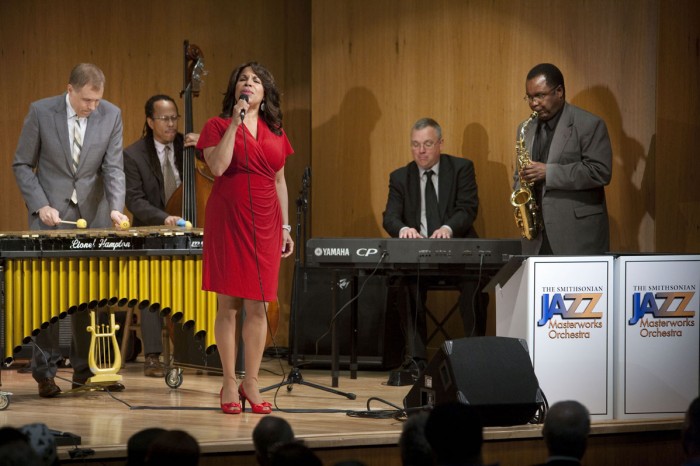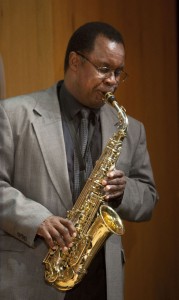April is Jazz Appreciation Month
The Smithsonian Jazz Masterworks Orchestra was founded in 1990 in recognition of the importance of jazz in American culture and its status as a national treasure. The 17-member big band serves as the American History Museum’s in-house orchestra and its performances include classic jazz, new arrangements, commissioned works and programs that illuminate the development of jazz as a uniquely American art form.
Charlie Young, coordinator of jazz studies at Howard University and a professor of saxophone, is the SJMO artistic director and conductor for the orchestra’s 2013 performance schedule. Young has been a member of the SJMO since 1995 and has served as the ensemble’s principal saxophonist for more than 15 years. He has shared the concert stage with many of the music industry’s leading icons ranging from Clark Terry and Ella Fitzgerald to Stevie Wonder and Quincy Jones in venues ranging from London’s Royal Albert Hall to New York’s Carnegie Hall.
In a recent conversation with the Torch, Young shared his early influences and explained how the innovative spirit that informs the free-wheeling nature of jazz is reflected in the Smithsonian’s mission.
Tell us a little about your background; how did you first get interested in music?
I was born and raised in Norfolk, Virginia and I first got involved with music as a kid starting with the seventh-grade band. I just thought the marching band looked so cool in their uniforms and I wanted to play a cool-looking instrument like the trumpet or the cornet. But when I actually went to the band director to join the band, they had a saxophone I could learn on, so that’s why I started playing baritone saxophone.
What led you to jazz?
I didn’t really become involved in jazz until I was at university. When I first started playing in seventh grade, I wanted to be a classical saxophone player. My band director, Carl W. Clark, introduced me to the recordings of a French musician named Marcel Mule and a German-born saxophone player named Sigurd Raschèr and said, ‘This is what the saxophone sounds like.’ Those were the first recordings I recall hearing of the classical saxophone and I couldn’t believe how amazing it sounded. I thought that classical playing was the most beautiful thing I’d ever heard and I pursued classical music throughout high school.
When I was a senior, a couple friends of mine were jazz-minded guys—you know, they knew all the Blue Note and Riverside records. They were my best friends and they wanted to go to school to study jazz. I wanted to go to Paris to study, but I didn’t know anyone who had ever been to Paris or even had been on an airplane, other than myself, so I ended up following my friends to North Texas State University [where the College of Music has a Division of Jazz Studies.]
So you came to jazz through kind of a side door?
Pretty much. My roommate in college was (and is) a jazz piano player and that’s when I started getting really involved. I had attempted to play some jazz when I was in high school but I knew nothing; I really just wasn’t in love with it then—I didn’t even know the names of jazz musicians.
How is playing jazz different from playing classical music?
The technique for classical saxophone requires a different skill set than that of a jazz musician although the two disciplines cross paths a little bit. For example, a lot of jazz music is created by the nuances of the way the timbre of the notes is altered and how the phrases are shaped and placed in time. Although a lot of jazz components are starting to bleed into the most contemporary classical music, traditional classical music is void of the inflections that are commonplace in jazz, so something as simple as how you play 8th notes is completely different between a classical approach to playing as opposed to a jazz approach to playing. That’s kind of putting things in a small box—the word “classical” encompasses a lot of different areas of European-style music; jazz music is also a big umbrella that covers a lot of areas, so I probably shouldn’t paint things with such a broad brush.
Jazz is innovative and improvisational with deep roots in Africa and Latin America—how are those influences translated into this unique American music?
One of the important components of jazz is the creative spirit of the actual performer. I think one of the reasons jazz thrived in places like New Orleans was that there were so many musical influences from so many people. As [National Endowment for the Arts Jazz Master] Randy Weston has said, you can hear the roots of the blues and of jazz in the sounds and rhythms of everyday life in Mali and other African countries today. Of course, many Africans were brought not only to the New Orleans and the southern United States but also to the Caribbean islands, and they brought the sounds of the blues with them.
If jazz is a musical style that originated with African Americans, it is improvisational because that is what black folks do. Black folk are improvisers in so many things that they do: I think of my mother going into the kitchen where there didn’t seem to be much food and somehow coming out with a four-course meal—she just figured out what was in the cabinet and made it happen. Or my father—when the car broke down, you didn’t call a mechanic, you got out there and figured it out and made it happen. Think of how slaves, with little food, were able to make use of what was left over after butchering a hog or a cow. That’s just improvisation: taking what you have and doing the best you can with it. There’s not a lot of difference when it comes to music: take the components of so many different styles, mix it up and see what happens. So the creativity and improvisational elements of jazz show themselves in the music but that’s just a function of the way black people are.
 We think of jazz as being primarily an urban genre. Do you still see it playing a role in those communities and resonating with young people? Is rap just another progression?
We think of jazz as being primarily an urban genre. Do you still see it playing a role in those communities and resonating with young people? Is rap just another progression?
Jazz is constantly changing; it cannot stay stagnant. Young people’s minds are constantly evolving and changing and they have different influences, so their music will always evolve as well. There are those who would like to take jazz and put it in a little box and won’t accept new things in jazz because they don’t have the same components of the music they are used to. Charlie Parker had great problems being accepted by a lot of the musicians during the 1940s because his style of playing was so different—‘What is that noise?’ Of course, the real hip jazz musicians were interested in what he was doing but a lot of the swing-era players did not really appreciate Charlie Parker or Thelonious Monk—they thought it just sounded like wrong notes because the music didn’t fall within the parameters they used to identify good quality jazz. John Coltrane and Les Paul faced the same thing during the 50s.
It takes history to look back over musical developments and realize what’s important. I think that the importance of what young people are doing today in rap and other forms will be recognized down the road one day, maybe when you and I are gone. I learn from my students way more than they could ever learn from me. I want to teach them jazz based on what I know but the realization that the sounds they create in their music are different means I have to leave room for that, whether I understand exactly what they are doing or whether I even like it. I have to accept the fact the maybe my not liking their music is based on my own ignorance and not on a lack of quality in what they’re doing.
Jazz must change because society changes. Jazz is, I believe, a reflection of musicians taking things that have been set down before them, taking them up and interpreting them based on their own experiences on this planet and coming up with whatever it is that comes out. Whether this encompasses the elements we think of as jazz, the future will decide.
There is a presumption that the Smithsonian is a caretaker of the past. The Jazz Masterworks Orchestra is obviously going to preserve the great musical traditions of jazz, but are you also thinking about preserving the tradition of innovation?
The mission of the orchestra is also that of the Institution; we serve as an archive of music that has been identified as worth preserving for the future—not necessarily just old stuff, but music that is relevant for the world. I think that the Jazz Orchestra will be focusing on understanding this legacy and presenting the music in a way that is as pure stylistically as we possibly can make it, realizing that relevance changes over time depending on changes in our culture. Just because someone plays something and just because it’s good, doesn’t mean that it’s something the Smithsonian should present. A lot of people have a lot of fans and make a lot of good music, but how do we decide what to preserve and present for the future? I think we make that decision by looking over our shoulder.
Listen to Charlie and the SJMO in performance:
The Smithsonian’s National Museum of American History is marking the 12th annual Jazz Appreciation Month with a global cultural perspective. A full schedule of events at the Smithsonian is available online.
Posted: 12 April 2013
-
Categories:
American History Museum , Collaboration , Feature Stories , History and Culture





